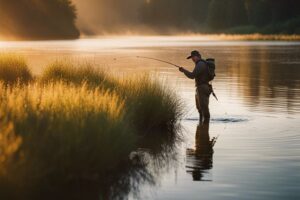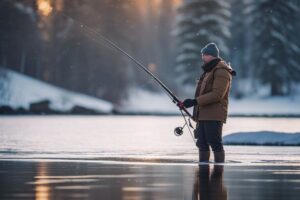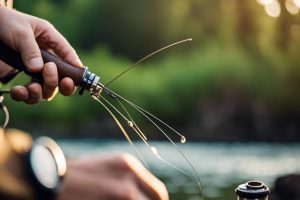As a beginner, you’re entering the intriguing world of fly tying. To get started, you’ll need a few important tools such as a vice, scissors, bobbin, and thread. Begin with simple patterns like the Woolly Bugger or Elk Hair Caddis as you hone your skills. Be mindful of, practice makes perfect. Stay focused, enjoy the process, and soon you’ll be creating your own beautiful flies to entice those elusive fish.
Key Takeaways:
- Tools: Essential tools for fly tying include a vise, bobbin, scissors, thread, hackle pliers, and a whip finish tool.
- MATERIALS: Basic materials for fly tying include hooks, thread, feathers, fur, and dubbing materials.
- Patterns: Beginners can start with simple patterns like Woolly Bugger, Elk Hair Caddis, and Pheasant Tail Nymph.
- Techniques: Learn techniques such as tying in materials, wrapping thread, and using hackle pliers for precision.
- Practice: Practice consistently to improve your skills in fly tying and develop your own patterns.
- Resources: Utilize online tutorials, books, and workshops to enhance your knowledge and skills in fly tying.
- Persistence: Fly tying can be challenging at first, but persistence and patience will lead to mastery of the craft.
Essential Tools for Fly Tying
Before you start creating your own flies, you’ll need to equip yourself with some imperative tools. These tools will serve as the foundation for your fly tying endeavors. Let’s explore some of the key tools you’ll need to get started.
Vise: The Foundation of Fly Tying
With a good-quality vise, you can securely hold your hook in place while you tie your fly. Look for a vise with adjustable jaws to accommodate different hook sizes. A rotary vise allows you to rotate the fly as you tie it, making the process more efficient and allowing for better access to all sides of the fly.
Bobbins and Bobbin Holders: Managing Thread and Wire
Tools such as bobbins and bobbin holders are imperative for managing your thread and wire. A bobbin holds your spool of thread in place, allowing you to easily control the amount of tension and thread you use. Bobbin holders help keep your bobbin in place and prevent it from slipping out of your hand while you tie your fly.
Plus, having multiple bobbins allows you to pre-load them with different colored threads, making it quicker and easier to switch between colors as you tie different parts of your fly.
Scissors: Cutting with Precision
Any fly tyer will tell you that a good pair of scissors is imperative for cutting materials with precision. Look for a pair of scissors specifically designed for fly tying, as they are typically sharper and more precise than regular scissors. A fine-tipped pair of scissors is ideal for trimming materials close to the hook without accidentally cutting the thread.
This imperative tool will be your go-to for trimming materials, thread, and wire to create clean, precise flies.
Whip Finisher: Tying Off with Ease
Cutting your thread and wire neatly is crucial for securing your fly and ensuring it holds up under pressure. A whip finisher is a tool that helps you create a knot to finish off your fly neatly and securely. This tool makes it easier to tie off your fly without leaving loose ends that could unravel over time.
Investing in a quality whip finisher will help you achieve professional-looking finishes on your flies, adding to their durability and overall appearance.
Basic Materials for Fly Tying
Hooks: The Backbone of Your Fly
Backbone
When considering fly tying, hooks are the necessary foundation of your creation. They come in various sizes, shapes, and materials, so it’s crucial to select the right hook for the specific fly pattern you’re tying. Make sure to have a variety of hook sizes in your toolkit, ranging from small to large, to accommodate different fly designs and target fish species.
Thread: Choosing the Right Color and Texture
Your
Thread may seem like a minor component, but it plays a significant role in securing materials and adding durability to your flies. Select threads of suitable color and texture that complement your fly pattern. A general rule of thumb is to match the thread color with the predominant color of your fly’s materials for a cohesive look.
This element shows that attention to detail is key in fly tying. Different thread textures can offer varying levels of grip, making them suitable for different types of flies. Experiment with different thread types to see which one works best for your tying style and preferred patterns.
Yarn and Dubbing: Adding Body and Texture
Adding
Yarn and dubbing are necessary for creating the body and texture of your flies. Yarn can be used to build up the body of larger flies, while dubbing adds a lifelike appearance and can imitate natural insect bodies. Different colors and textures of yarn and dubbing can be combined to create intricate patterns and imitate specific prey items.
With a bit of practice, you’ll learn to manipulate yarn and dubbing to achieve the desired shape and texture for your flies. These materials are versatile and can be used in various fly patterns, making them necessary additions to your fly tying kit.
Feathers and Hair: Adding Movement and Life
Hair
Feathers and hair are necessary for adding movement and realism to your flies. Select feathers with suitable length and flexibility for your patterns, as they can be used for wings, tails, and other key features. Additionally, hair materials like deer hair or elk hair can be used to create buoyant flies for surface fishing.
Experiment with different feather and hair placements to achieve natural movement and appearance in your flies. These materials add a dynamic element to your creations, making them more enticing to fish and increasing your chances of a successful catch.
Simple Fly Patterns for Beginners
Your journey into fly tying starts with mastering some simple patterns that are perfect for beginners. To begin, familiarize yourself with the necessary tools required for fly tying. If you need guidance on basic tools, check out this Guide To Basic Fly Tying Tools to set yourself up for success.
Dry Fly: The Classic Elk Hair Caddis
Patterns such as the Elk Hair Caddis are excellent options for beginners as they are relatively easy to tie and versatile in various fishing conditions.
Nymph: The Simple Hare’s Ear
Patterns like the Hare’s Ear Nymph are a great starting point for those new to tying flies. These patterns mimic underwater insect larvae, a common food source for fish, making them effective in a variety of situations.
Understanding the basic techniques in tying patterns like the Hare’s Ear Nymph will lay a solid foundation for your future fly tying endeavors.
Streamer: The Easy Woolly Bugger
Regarding creating streamer patterns, the Woolly Bugger is a classic and straightforward option for beginners. This pattern imitates small baitfish or leeches, making it attractive to various fish species.
This selection of simple fly patterns will help you hone your fly tying skills and prepare you for more advanced patterns in the future. Happy tying!
Basic Fly Tying Techniques
Unlike fly fishing, where the art lies in casting the perfect line, fly tying is a skill that allows you to create your own custom flies to attract fish. To get started, you’ll need imperative tools such as vise, scissors, thread, and hooks. You can find a detailed guide on the basic tools and simple patterns to try in the Beginners Fly Tying Guide: The Basic Tools and 5 Patterns to Tie.
Tying the Knot: Securing the Hook
Basic fly tying begins by securing the hook in the vise. Use your fingers to hold the hook in place while wrapping the thread around the shank to create a foundation. This foundation ensures that the materials you add later will stay in place securely.
Wrapping the Thread: Building the Fly’s Body
The next step involves wrapping the thread along the shank of the hook to build the body of the fly. This thread provides a base for adding additional materials like feathers or fur to create the desired shape and profile for your fly.
Body.
Shaping the Fly: Creating the Desired Form
Wrapping materials around the thread body allows you to shape the fly into the desired form. By carefully layering and securing materials with thread wraps, you can achieve the silhouette and movement necessary to imitate natural insects or baitfish.
Desired.
Tips for Improving Your Fly Tying Skills
Despite your best efforts, you may find that your initial fly tying attempts are less than perfect. That’s okay – it takes time to master this skill. Here are some tips to help you hone your fly tying abilities:
- Practice regularly to develop your tying technique.
- Pay attention to the details, such as thread tension and proportions.
- Experiment with different materials and patterns to broaden your skills.
Assume that with patience and dedication, you will see improvement in your fly tying skills over time.
Practice Makes Perfect: Start with Simple Flies
Flies that require only a few materials and basic tying techniques are the best way to start honing your skills. Simple patterns like the Woolly Bugger or the Elk Hair Caddis are great for beginners to practice their tying technique.
Watch and Learn: Online Tutorials and Videos
An excellent way to improve your fly tying skills is by watching online tutorials and videos. Many experienced fly tyers share their expertise on platforms like YouTube, where you can learn new techniques and patterns from the comfort of your own home.
Tutorials covering a wide range of fly tying topics, from basic techniques to advanced patterns, are readily available online. Watch these videos, take notes, and incorporate what you’ve learned into your own tying practice.
Join a Community: Fly Tying Clubs and Forums
The fly tying community is a welcoming and supportive group of individuals who are passionate about the art of fly tying. Connecting with fellow fly tyers through clubs and online forums can provide you with valuable feedback, tips, and inspiration for your own tying projects.
Another benefit of joining a fly tying community is the opportunity to participate in fly tying events, workshops, and competitions. These experiences allow you to learn from others, showcase your skills, and further your development as a fly tyer.
Common Mistakes to Avoid
Over-Tightening the Knot
Once again, when tying flies, it is crucial to pay attention to the knot’s tightness. One common mistake beginners make is over-tightening the knot, which can weaken the material and cause it to break easily. Recall, a firm but gentle tug is all you need to secure the knot properly.
Inconsistent Thread Tension
One mistake to avoid when tying flies is having inconsistent thread tension. This can result in a messy and less durable fly. Make sure to maintain a steady and even tension on the thread as you wrap it around the hook. Practice controlling the tension with your fingers to achieve a smooth and uniform appearance.
Avoid having loose or tight spots in the thread, as this can affect the overall quality and durability of the fly. Pay attention to your thread tension throughout the tying process to produce well-crafted flies.
Poor Material Selection
Overtightening is another common mistake to avoid when selecting materials for fly tying. Choosing materials that are too stiff or fragile can make it difficult to work with and result in flies that don’t perform well in the water. Select materials that are appropriate for the fly pattern you are tying and ensure they are of good quality to create effective and durable flies.
Avoid using materials that are too heavy or bulky for the fly pattern, as this can affect its ability to float or sink properly. Consider the characteristics of each material and how they will contribute to the overall functionality of the fly when making your selections.
Upon reflecting
As you launch on your fly tying journey, be sure to arm yourself with the necessary tools: a vise, scissors, bobbin, thread, hackle pliers, and whip finish tool. With these tools in hand, you can start exploring simple patterns like the Woolly Bugger, Pheasant Tail Nymph, and Elk Hair Caddis. Remember to practice patience and precision in your tying, as each step plays a crucial role in creating an effective fly.
By mastering the basics of fly tying and experimenting with different patterns, you will not only hone your fishing skills but also tap into a creative and meditative practice. So gather your tools, select your materials, and immerse yourself in the art of fly tying – the possibilities are endless, and the rewards are bountiful. Happy tying, and may your flies always attract the elusive catch!
FAQ
Q: What is fly tying?
A: Fly tying is the art of creating artificial flies used in fly fishing. Anglers use these flies to imitate natural insects, baitfish, or other prey to attract fish.
Q: What tools are vital for fly tying?
A: Essential tools for fly tying include a vise to hold the hook, scissors for cutting materials, a bobbin to hold thread, hackle pliers for handling feathers, and a whip finish tool for securing the thread.
Q: What materials are commonly used in fly tying?
A: Common materials used in fly tying include feathers, fur, hair, thread, tinsel, and beads. These materials are used to create the body, wings, and other components of the fly.
Q: What are some simple fly patterns for beginners to start with?
A: Some simple fly patterns for beginners to start with include the Woolly Bugger, Elk Hair Caddis, and Griffith’s Gnat. These patterns are effective for a variety of fish species.
Q: How can I learn more about fly tying techniques?
A: You can learn more about fly tying techniques by watching tutorial videos online, attending fly tying workshops or classes, and reading books or magazines on the subject.
Q: Is fly tying a cost-effective hobby?
A: While there is an initial investment in tools and materials, fly tying can be a cost-effective hobby in the long run. Anglers can create their own flies at a fraction of the cost of buying them from a store.
Q: Can I create my own unique fly patterns?
A: Yes, fly tying allows for creativity and experimentation. Once you have mastered the basics, you can begin to create your own unique fly patterns tailored to the specific conditions of your fishing spot.


